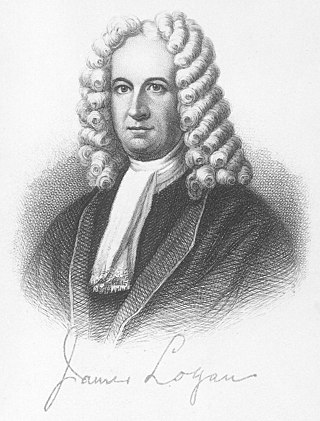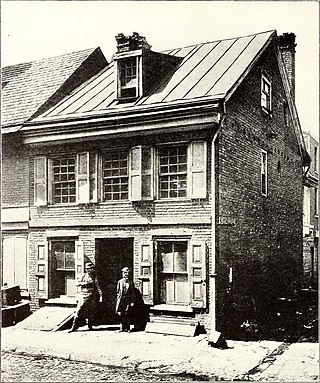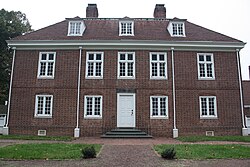
Falls Township is a suburban Philadelphia township in Bucks County, Pennsylvania, United States. The population was 34,300 at the 2010 census. Portions of Fairless Hills and Levittown, Pennsylvania, are located in the township. Portions of Falls Township are called Morrisville and Yardley, due to the location of the Morrisville Post Office outside the Borough of Morrisville in Falls Township. As originally chartered in 1692, the villages of Morrisville and Tullytown were part of Falls Township. Morrisville was granted borough status in 1804. Tullytown was established as a borough in 1891.

The Lenape, also called the Lenni Lenape and Delaware people, are an Indigenous people of the Northeastern Woodlands, who live in the United States and Canada.

Hannah Margaret Penn was an Anglo-American governor. The second wife of Pennsylvania founder William Penn, she effectively administered the Province of Pennsylvania for six years after her husband suffered a series of strokes, and then for another eight years after her husband's death. She served as acting proprietor from 1712 until her death in 1726.

The Province of Pennsylvania, also known as the Pennsylvania Colony, was a British North American colony founded by William Penn, who received the land through a grant from Charles II of England in 1681. The name Pennsylvania was derived from "Penn's Woods", referring to William's father Admiral Sir William Penn.

The Walking Purchase, also known as the Walking Treaty, was a 1737 agreement between the Penn family, the original proprietors of the Province of Pennsylvania, later the Commonwealth of Pennsylvania, and the Lenape native Indians. In the purchase, the Penn family and proprietors claimed that a 1686 treaty with the Lenape ceded an area of 1,200,000 acres (4,860 km2) in present-day Lehigh Valley and Northeastern Pennsylvania, which included a western land boundary extending as far west as a man could walk in a day and a half, which led to its name.

James Logan was a Scots-Irish colonial American statesman, administrator, and scholar who served as the fourteenth mayor of Philadelphia and held a number of other public offices.

The 1696 Thomas Massey House is one of the oldest English Quaker homes in the Commonwealth of Pennsylvania. It is a 2-story brick and stone house, originally constructed by the English, Quaker settler, Thomas Massey in 1696. It is located on Lawrence Road near Sproul Road in Broomall, Pennsylvania.

The Slate Roof House was a mansion that stood on 2nd Street north of Walnut Street in Philadelphia, Pennsylvania, from about 1687 until its demolition in 1867. Built for Barbadian Quaker merchant Samuel Carpenter, the house occupied a small hill overlooking the Delaware River. It was built of brick]in the Jacobean style with its façade featuring two projecting wings that flanked a recessed central entrance. The house was notable for its large size as well for its slate roof, which was a rarity in early Philadelphia.

The Conrad Weiser Homestead was the home of Johann Conrad Weiser, who enlisted the Iroquois on the British side in the French and Indian War. The home is located near Womelsdorf, Berks County, Pennsylvania in the United States. A designated National Historic Landmark, it is currently administered as a historic house museum by the Pennsylvania Historical and Museum Commission. The historic site was established in 1923 to preserve an example of a colonial homestead and to honor Weiser, an important figure in the settlement of the colonial frontier.

Thomas Penn was an English landowner and mercer who was the chief proprietor of Pennsylvania from 1746 to 1775. He was one of 17 children of William Penn, the founder of the colonial-era Province of Pennsylvania in British America. In 1737, Thomas Penn negotiated the Walking Purchase, a contested land cession treaty he negotiated with Lenape chief Lappawinsoe that transferred control over 1,200,000 acres (4,860 km2) of territory in the present-day Lehigh Valley and Northeastern Pennsylvania regions of Pennsylvania and a portion of West Jersey in colonial New Jersey from the Lenape tribe to the Province of Pennsylvania.

Conrad Weiser, born Johann Conrad Weiser, Jr., was a Pennsylvania Dutch (German) pioneer who served as an interpreter and diplomat between the Pennsylvania Colony and Native American nations. Primarily a farmer, he also worked as a tanner, and later served as a soldier and judge. He lived part of the time for six years at Ephrata Cloister, a Protestant monastic community in Lancaster County.

Teedyuscung was known as "King of the Delawares". He worked to establish a permanent Lenape (Delaware) home in eastern Pennsylvania in the Lehigh, Susquehanna, and Delaware River valleys. Teedyuscung participated in the Treaty of Easton, which resulted in the surrender of Lenape claims to all lands in Pennsylvania. Following the treaty, the Lenape were forced to live under the control of the Iroquois in the Wyoming Valley near modern-day Wilkes-Barre. Teedyuscung was murdered by arsonists in the night of April 19, 1763. This marked the beginning of the end of the Lenape presence in Pennsylvania. Teedyuscung's son Chief Bull conducted a raid on the Wyoming Valley that was part of a greater Indian uprising. As a result, the Lenape were forced to move west of the Appalachian Mountains by the Royal Proclamation of 1763.
John Penn was an American-born merchant who was proprietor of the colonial Province of Pennsylvania, which became the U.S. state of Pennsylvania following American independence obtained in victory in the American Revolutionary War.

First State National Historical Park is a National Park Service unit which lies primarily in the state of Delaware but which extends partly into Pennsylvania in Chadds Ford. Initially created as First State National Monument by President Barack Obama under the Antiquities Act on March 25, 2013, the park was later redesignated as First State National Historical Park by Congress.

Glen Foerd is a historic mansion and estate located in the Torresdale neighborhood of Philadelphia, Pennsylvania, overlooking the Delaware River near the mouth of Poquessing Creek.
William Biles was an American judge, attorney, legislator, sheriff, land speculator and merchant. Born in England and educated in law, Biles brought his family to America in 1679 and settled in what would become Falls Township, Bucks County, Pennsylvania, before the charter of William Penn. The Biles family had been persecuted for their religious dissension in England, and William became a prominent Quaker minister. "After the withdrawal of the Declaration of Indulgence dissenters were more often punished for being absent from their parish churches... Quakers were always fair game and in the following spring (1674) two of them, William Biles and Thomas Strong, were presented at the Assizes." Presumably punishment for being absent from their parish church and attending Quaker ceremonies.

Richardson Brognard Okie Jr. (1875-1945) was an American architect. He is noted for his Colonial-Revival houses and his sensitive restorations of historic buildings.

The Okehocking Tribe was a small band of Unami language-speaking Delaware Indians, who occupied an area along the Ridley and Crum creeks in Delaware County, Pennsylvania. Part of that area is now known as Ridley Creek State Park. Along with the Schuylkill and Brandywine Indians, the Okehocking were known as Unami or "people down the river" by other tribes, in accordance with the Indian way of designating a tribe by geographical location.

Letitia Street House is a modest eighteenth-century house in West Fairmount Park, Philadelphia. It was built along the Delaware riverfront about 1713, and relocated to its current site in 1883. The house was once celebrated as the city residence of Pennsylvania's founder, William Penn (1644–1718); however, later historical research determined that he never lived there.

Thomas Rutter was an American ironmaster and abolitionist who constructed the first blast furnace and the first iron forge in the Province of Pennsylvania. Now known as Pine Forge Mansion and Industrial Site, the location of Rutter's mansion and iron plantation was listed on the National Register of Historic Places in 2004. The site has been the campus of Pine Forge Academy since 1945.






















